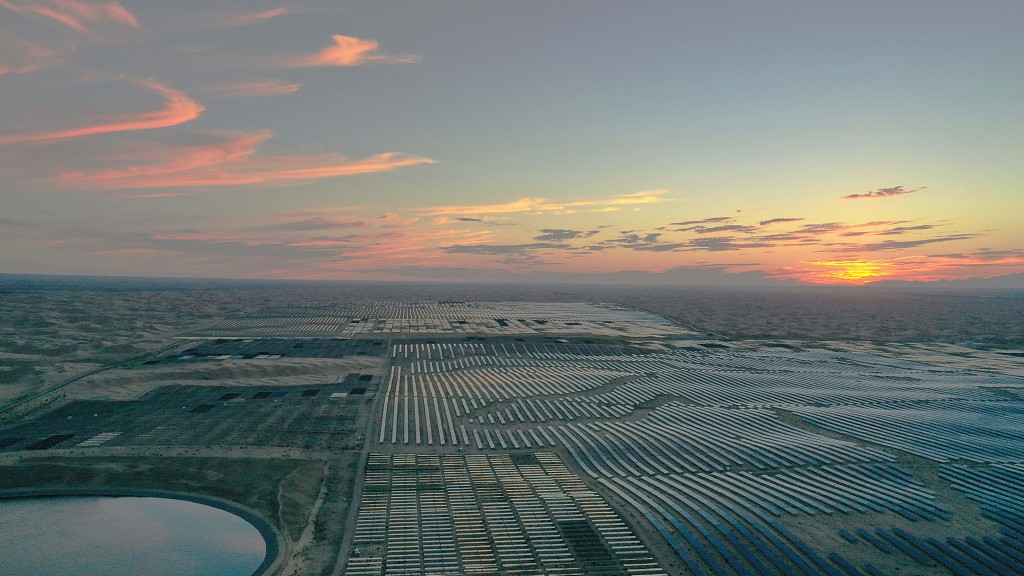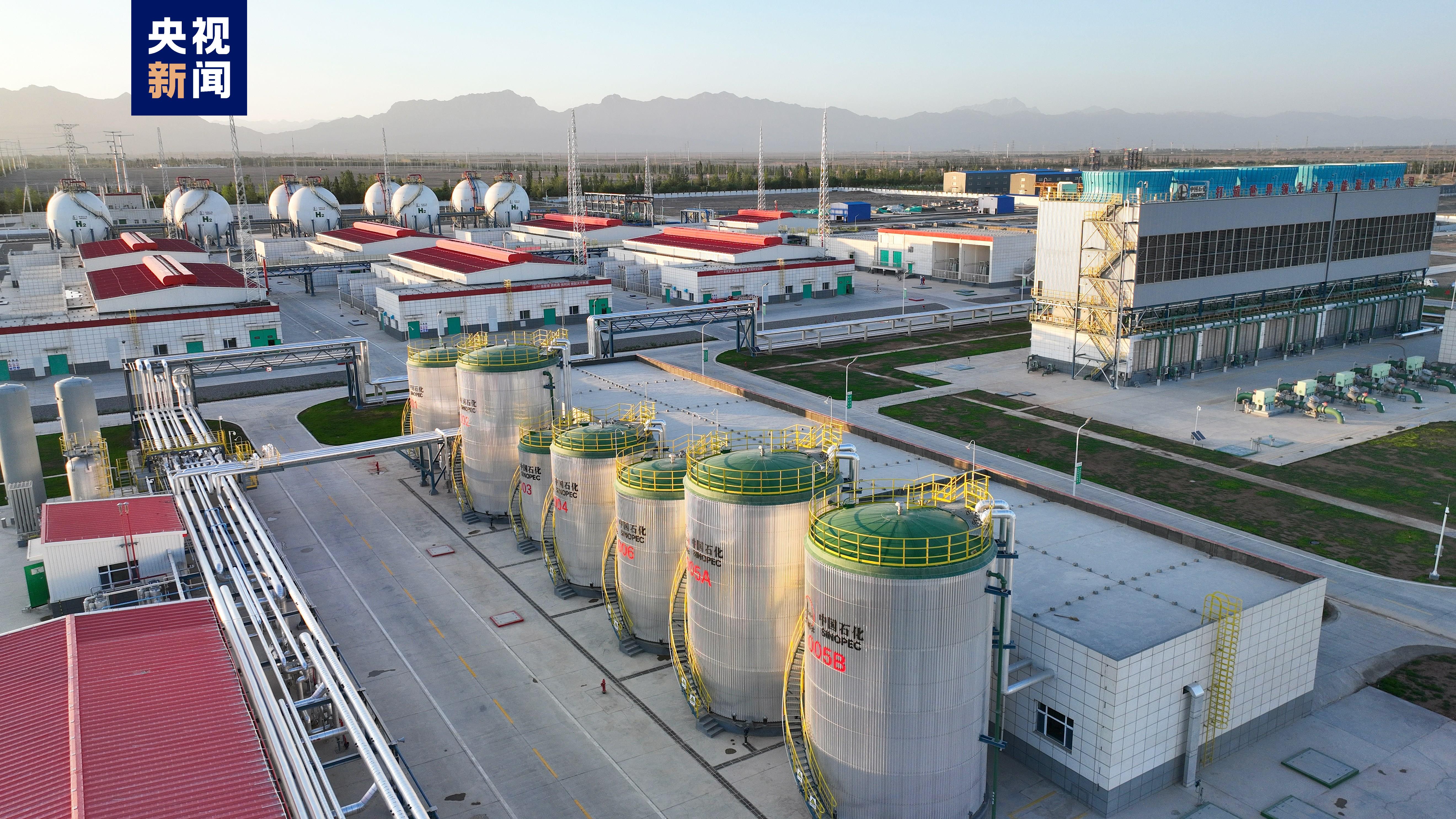
A bird's-eye view of a solar energy power station in Ordos City, north China's Inner Mongolia Autonomous Region, July 17, 2022. /CFP
A bird's-eye view of a solar energy power station in Ordos City, north China's Inner Mongolia Autonomous Region, July 17, 2022. /CFP
The world's largest green hydrogen project, which generates hydrogen from solar and wind renewables without emitting carbon dioxide, produced its first batch of "green hydrogen" on Thursday in Ordos, Inner Mongolia Autonomous Region in north China.
According to the World Economic Forum's latest white paper, China is the largest producer and consumer of hydrogen globally, but less than 0.1 percent of the hydrogen it produces comes from renewable energy sources.
This new project is anticipated to yield an annual production of 30,000 tonnes of green hydrogen and 240,000 tonnes of green oxygen, resulting in a reduction of approximately 1.43 million tonnes of carbon dioxide emissions per year. To put it in perspective, this reduction is equivalent to planting 825,000 trees. China Petroleum & Chemical Corporation (Sinopec), the country's largest hydrogen producer, provided this information.
Making full advantage of its bountiful wind and solar resources, Ordos is an ideal location for the green project. The initiative combines two clean energy sources: solar power and hydrogen. It employs an electrolysis device that utilizes green electricity generated from solar energy to decompose water into hydrogen and oxygen.
The project marks Sinopec's second green hydrogen project, following the one in Kuqa City, northwest China's Xinjiang Uygur Autonomous Region, the construction of which began in 2021. Liu Shiliang, general manager of Sinopec Star, told China Media Group (CMG) that the Kuqa plant went into operation on Friday with hydrogen purity reaching 99.9 percent.
The hydrogen production capacity electrolyzed water of the Kuqa plant is 20,000 tonnes per year, and the hydrogen storage capacity is 210,000 standard cubic meters, with the hydrogen transmission capacity reaching 28,000 standard cubic meters per hour.
The green hydrogen and green oxygen produced by the project will be transported through pipelines to a coal-deep processing project. This will replace the existing coal-to-hydrogen process, promoting the clean and low-carbon transformation of coal-powered chemical products. Xu Zhendong, the executive director of Sinopec Star Petroleum's Inner Mongolia branch, shared this information with CMG.
By exploring a pollution-free and zero-energy approach, this new hydrogen production model addresses a crucial issue of power balance and consumption in the grid's high proportion of renewable energy connections.

China tests its hydrogen production technology at sea with a direct seawater electrolysis method on Friday at the Xinghua Bay offshore wind farm, southeast China's Fujian Province, June 2, 2023. /CMG
China tests its hydrogen production technology at sea with a direct seawater electrolysis method on Friday at the Xinghua Bay offshore wind farm, southeast China's Fujian Province, June 2, 2023. /CMG
Tech-driven production
Green hydrogen has emerged as a crucial component in the development of the hydrogen industry, offering a pathway towards a low-carbon and sustainable future, according to an expert who spoke at the World Hydrogen Technology Convention 2023 last month.
By the end of 2022, the number of fuel cell vehicles in the world had reached 67,000, a 36 percent increase year on year. Hydrogen energy technology research and development and industrial development have entered a new stage of rapid development, said Wan Gang, chairman of the China Association for Science and Technology.
Wan stressed the significance of the synergy among industries to break through in key technologies and high-level international cooperation in hydrogen energy development.
Hydrogen can be produced from various sources of energy such as coal, natural gas and renewable energy through power generation. Electrolysis can extract hydrogen, which can be stored and converted into electricity again when needed.
In addition to the chemical industry, steel industry and other traditional industrial domains, hydrogen is used in the fields of energy, transportation and construction.
Green hydrogen is called "green" thanks to its origin of renewable energy such as wind and photovoltaic power, making it one of the most eco-friendly technologies. China's green hydrogen production costs are declining as a result of increased technological breakthroughs.
The development of China's hydrogen energy sector is in its early stages, with the application scenario continuing to expand.
The country recently tested its hydrogen production technology at sea with a direct seawater electrolysis method, which was verified by a team of experts from the Chinese Academy of Engineering (CAE).
The platform is the world's first platform combined with renewable energy, said the Sichuan-based enterprise, one of the world's largest manufacturers of power-generating equipment.
It is integrated into multiple systems, including in situ hydrogen production, intelligent energy conversion management, and safety detection and control systems.
Currently, water electrolysis technologies rely on ultrapure freshwater. Experts said that the new method can separate the influence of more than 90 complex elements and microorganisms in seawater, breaking the common methods for hydrogen production.

Sinopec's green hydrogen project in Kuqa City, northwest China's Xinjiang Uygur Autonomous Region. /CMG
Sinopec's green hydrogen project in Kuqa City, northwest China's Xinjiang Uygur Autonomous Region. /CMG
Chase on clean energy
As China pursues an ambitious campaign to transition toward renewable energy, the National Development and Reform Commission issued the country's first long-term hydrogen plan on March 23, mapping out the development of its green hydrogen energy through 2035.
China produced about 33 million tonnes of hydrogen in 2021, making it the world's largest hydrogen producer.
The country aims to establish an ecosystem of diverse green hydrogen applications including transportation and energy storage. Green hydrogen's portion of overall energy consumption is forecasted to expand dramatically, assisting China's clean energy transition.
China plans to build an over-400-km hydrogen pipeline to more effectively transfer clean fuel from the resources-rich west to energy-consuming regions in the east.
The project is designed to channel hydrogen from Ulanqab, north China's Inner Mongolia Autonomous Region, to Beijing, the supply from Inner Mongolia will replace the current hydrogen production from fossil fuels in the Beijing-Tianjin-Hebei region, play a pioneering role in trans-regional hydrogen transmission, and help promote the country's energy upgrades, said Ma Yongsheng, chairman of Sinopec, China's largest oil refiner and operator of the pipeline.
By 2025, China will have about 50,000 hydrogen fuel-cell vehicles and its annual hydrogen production from renewable energy will reach 100,000 to 200,000 tonnes through renewables and cut carbon dioxide emissions by 1 million to 2 million tonnes, according to the plan jointly released by the National Development and Reform Commission, and the National Energy Administration.